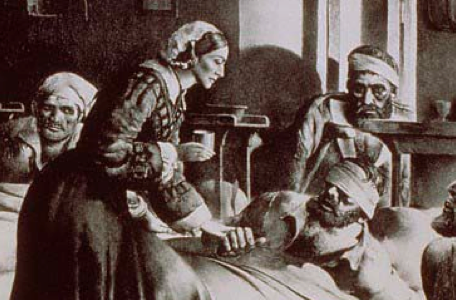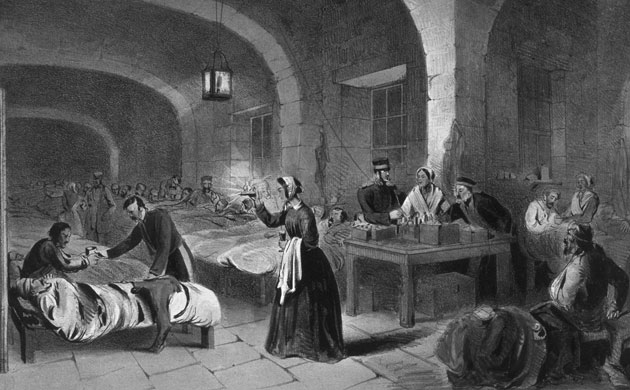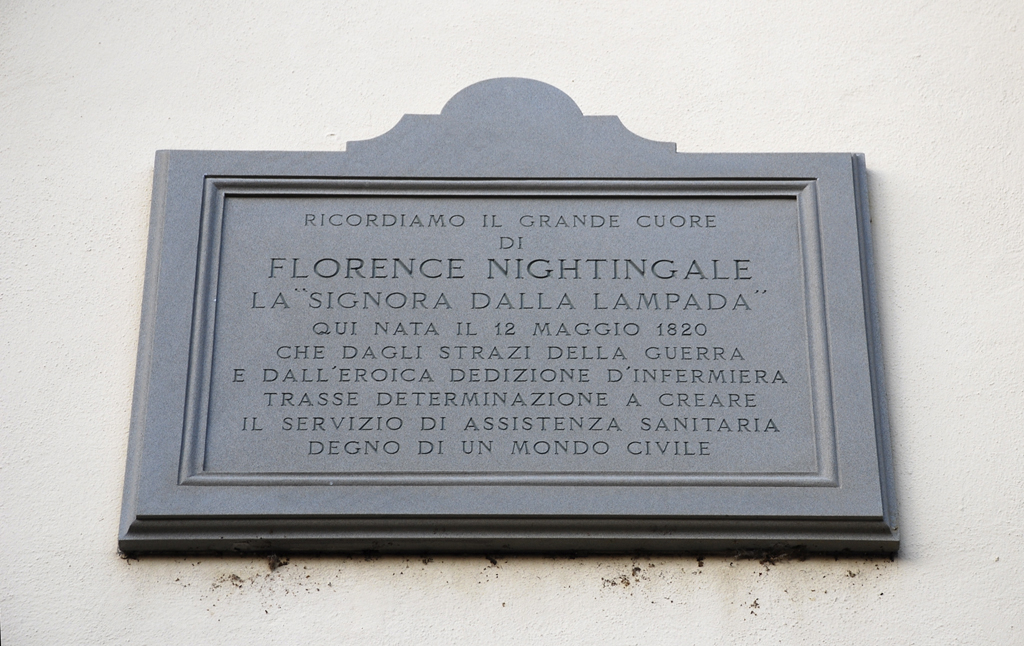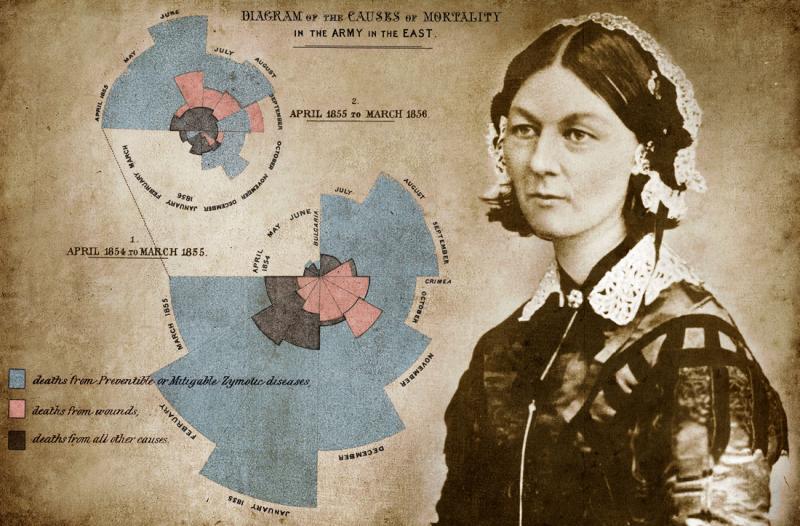 She was an active supporter of women’s rights and was influenced by Elizabeth Blackwell who was the first woman to qualify as a doctor in the America. In 1847 she also met and remained friends with Sidney Herbert, Secretary at War. He was to be a great ally when she needed support for her cause. In 1853 she was appointed Superintendent of the Institution for the Care of Sick Gentlewomen in Harley Street, London.
War and the lamp
The Crimean War broke out in 1854 when Russia invaded Turkey. Men were dying from war wounds and thousands succumbed to cholera and malaria. Miss Nightingale volunteered to go and nurse the British troops in Constantinople. At the Barrack Hospital in Scutari she found appalling conditions. Soldiers were still in the clothing that they were wearing when injured. She and her nurses washed and cleaned and scrubbed. A complete hospital was built in England and shipped in pieces to the Dardanelles. This hospital was more hygienic and lives were saved.
She was an active supporter of women’s rights and was influenced by Elizabeth Blackwell who was the first woman to qualify as a doctor in the America. In 1847 she also met and remained friends with Sidney Herbert, Secretary at War. He was to be a great ally when she needed support for her cause. In 1853 she was appointed Superintendent of the Institution for the Care of Sick Gentlewomen in Harley Street, London.
War and the lamp
The Crimean War broke out in 1854 when Russia invaded Turkey. Men were dying from war wounds and thousands succumbed to cholera and malaria. Miss Nightingale volunteered to go and nurse the British troops in Constantinople. At the Barrack Hospital in Scutari she found appalling conditions. Soldiers were still in the clothing that they were wearing when injured. She and her nurses washed and cleaned and scrubbed. A complete hospital was built in England and shipped in pieces to the Dardanelles. This hospital was more hygienic and lives were saved.
 Florence Nightingale became known as the ’lady with the lamp’ as each night she alone walked the wards with her lamp giving comfort to the sick and dying soldiers. Her nurses were forbidden to be in the wards after 8pm to avoid transgressions.
In 1856 she was made General Superintendent of the Female Nursing Establishment of the Military Hospitals of the Army and she was able to improve conditions for British soldiers. Many celebrities of the day supported her cause, she was a woman of good reputation and had influential friends. Charles Dickens was one of these and on his advice a drying closet machine made by William Jeakes was sent to the hospital so that the clothes could be cleaned and returned in the least time.
Pushing for change
It was in this year too that she had an interview with Queen Victoria herself and by 1897 a Royal Commission of the Health of the Army was appointed. Consequently The Army Medical School was set up.
When the war in India broke out another Royal commission was appointed The Sanitary Department in The India Office.
In 1860 The Nightingale School for Nurses was set up at St Thomas’ Hospital, a first in the world. Nightingale used the funds that the grateful public had donated in appreciation of her work. In 1883 she was awarded ‘The Royal Red Cross.’
Her own sickness
By 1901 Florence Nightingale the woman who spent her life caring for the sick sadly ended up herself an invalid and blind. In her last years she did not venture much from her home. In 1907 the Order of merit was conferred on her by King Edward VII.
She died on 13 August 1910 and was buried in the family grave in East Wellow, Hampshire, as she wished. She had been offered burial in Westminster Abbey prior to her death but she had declined this offer.
Legacy
She wrote over two hundred books, reports and pamphlets and both her ‘Notes on Hospitals’ and ’Notes on Nursing’ written in1859 are still used as references for Nurses in training today.
Although she spent the major part of her life away from Italy her birthplace at Villa Colombaia is considered important and many an admirer, especially devoted nurses, visit this site. She was and still is an inspiration to women.
Florence Nightingale became known as the ’lady with the lamp’ as each night she alone walked the wards with her lamp giving comfort to the sick and dying soldiers. Her nurses were forbidden to be in the wards after 8pm to avoid transgressions.
In 1856 she was made General Superintendent of the Female Nursing Establishment of the Military Hospitals of the Army and she was able to improve conditions for British soldiers. Many celebrities of the day supported her cause, she was a woman of good reputation and had influential friends. Charles Dickens was one of these and on his advice a drying closet machine made by William Jeakes was sent to the hospital so that the clothes could be cleaned and returned in the least time.
Pushing for change
It was in this year too that she had an interview with Queen Victoria herself and by 1897 a Royal Commission of the Health of the Army was appointed. Consequently The Army Medical School was set up.
When the war in India broke out another Royal commission was appointed The Sanitary Department in The India Office.
In 1860 The Nightingale School for Nurses was set up at St Thomas’ Hospital, a first in the world. Nightingale used the funds that the grateful public had donated in appreciation of her work. In 1883 she was awarded ‘The Royal Red Cross.’
Her own sickness
By 1901 Florence Nightingale the woman who spent her life caring for the sick sadly ended up herself an invalid and blind. In her last years she did not venture much from her home. In 1907 the Order of merit was conferred on her by King Edward VII.
She died on 13 August 1910 and was buried in the family grave in East Wellow, Hampshire, as she wished. She had been offered burial in Westminster Abbey prior to her death but she had declined this offer.
Legacy
She wrote over two hundred books, reports and pamphlets and both her ‘Notes on Hospitals’ and ’Notes on Nursing’ written in1859 are still used as references for Nurses in training today.
Although she spent the major part of her life away from Italy her birthplace at Villa Colombaia is considered important and many an admirer, especially devoted nurses, visit this site. She was and still is an inspiration to women.
 Monuments and a museum in London, a famous recording of her own voice, CFS Awareness day held on her birth date and, besides the Queen, the only woman to have her image on a bank note, are all a tribute to this lady and her work.
Florence Nightingale lit the way for others, making nursing a respectable career, and has been called the Founder of Modern Nursing. The legacy from this visionary woman is indeed to be treasured.
Monuments and a museum in London, a famous recording of her own voice, CFS Awareness day held on her birth date and, besides the Queen, the only woman to have her image on a bank note, are all a tribute to this lady and her work.
Florence Nightingale lit the way for others, making nursing a respectable career, and has been called the Founder of Modern Nursing. The legacy from this visionary woman is indeed to be treasured.









